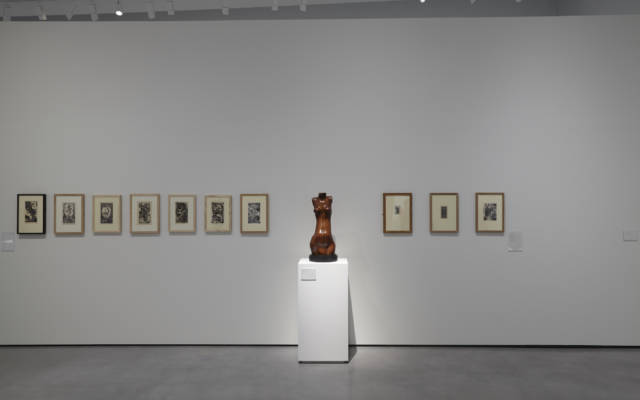
This was the first UK retrospective of British artist Gertrude Hermes’s work in 30 years. The exhibition offered a new and fresh perspective on one of the most important British female artists of the twentieth century, and for the first time drew together the dialogue between her two-dimensional and three-dimensional work, showcasing her artistic journey – from schoolgirl, to teacher, engraver and sculptor, illustrator and craftswoman.
Hermes (1901-1983) was one of the most highly acclaimed British print-makers of her generation. While her exquisite wood engravings and prints earned her awards, titles and recognition, her first love was sculpture, much of which has remained unseen by a wider public until now. The exhibition Wild Girl: Gertrude Hermes sought to redress this balance by presenting a compelling insight into Hermes’ audacious draughtsmanship and its extraordinary and explicit relationship to her sculpture.
There were more than 35 sculptures by Hermes including decorative commissions and over 60 works on paper, alongside rarely seen school-girl notebooks, sketchpads, artists’ woodblocks, private press books, zoo drawings and a portrait of Hermes by her former tutor Leon Underwood.
Hermes’ work as a designer of architectural features, door-knockers, car mascots and commissioned book illustration is also re-examined in light of her prodigious sculptural output. Architectural and decorative commissions included a fountain for the Shakespeare Memorial Theatre in Stratford-upon-Avon, as well as weather vanes and door furniture.
‘The Hepworth Wakefield has done it again. Their programme consistently delivers world-class exhibitions that are original and surprising – and what they are particularly good at is showcasing the work of artists who, for whatever reason, may not be widely known.’
Yvette Huddleston, Yorkshire Post
Wild Girl presented the two distinct strands of the artist’s sculpture: carvings of organic forms, and highly representational sculptural portraits of friends, family and commissioned subjects, including a bronze of two of her children Judith and Simon (c. 1939). The persistence of natural forms in the work is demonstrated across time and medium; for example, an early drawing from nature featuring the heart shape of a fern’s reproductive organs in her school girl sketchbooks, reappears many years later in the form of a sculptural work The Heart (1934) and the intricate engraving Five Senses (1934).
Other examples of Hermes’ love of nature can be seen in her earliest sculptures, stone carvings of cows, birds, frogs and a rabbit made during the 1920s through to Butterfly (1937) a hand carved sculpture in walnutwhich made its debut at the London Group exhibition in 1937. While she was carving these extraordinary and vital sculptures, Hermes’ was also addressing the same subjects in her engravings, often as illustrations for books such as Gilbert White’s Natural History of Selbourne or the famous The Compleat Angler.
In 1945 Hermes began to introduce colour into her graphic work which still focused on natural themes. One of the most extraordinary of these was based on a drawing Hermes made while staying at the country home of her dear friend, the author Naomi Mitchison, in Carradale, in the Mull of Kintyre, Scotland. Ring Net Fishers depicts five fisherman on a boat hauling in a circular or ‘ring’ net which is one of the ways salmon are caught off the Scottish coast. This relationship with Mitchison was one of many that contributed to the networks of creativity, influence and friendship that included Henry Moore, P. L. Travers (for whom she illustrated the first edition of I Go by Sea, I Go By Land) and Frieda Lawrence.

This exhibition was supported by
The Henry Moore Foundation.







